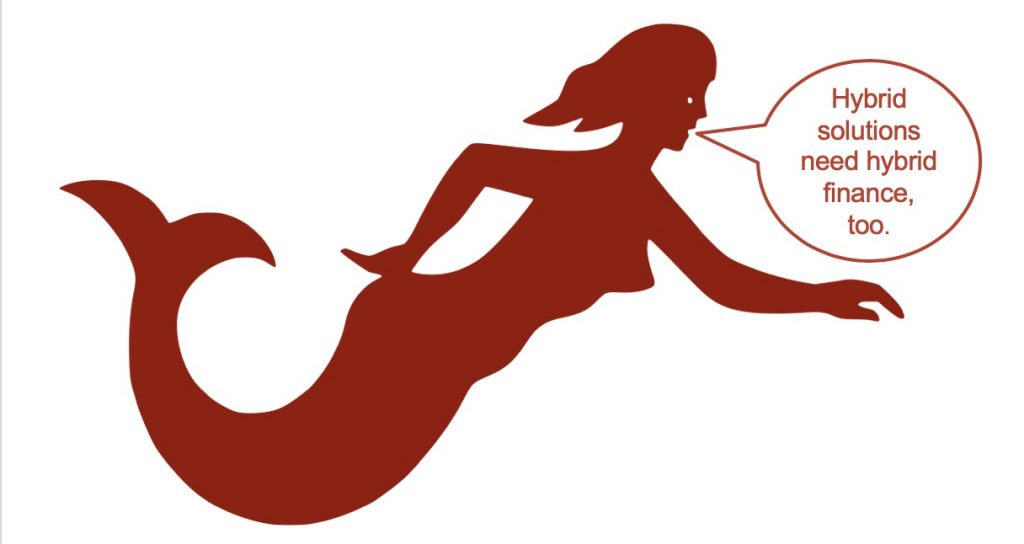Like mermaids, hybrid inclusive business solutions combine the best of two worlds: they achieve social objectives that are typically within the realm of public sector with market-based approaches at home in the private sector. This mixture comes with limitations: while hybrid inclusive businesses have revenues from customers, these do not fully cover the operating and capital expenditures, and have no perspective of doing so in the future. In many cases, direct costs are covered, but overheads and scale-up investments are financed by grants. Examples exist across the spectrum from social enterprises to NGO’s earned income strategies to corporate shared value initiatives: low-cost schools, food fortification, solar kiosks, water kiosks etc. Many of these initiatives claim that they will become financially sustainable with scale. But in reality, even solutions with a solid social impact often close down when grants dry up. We can avoid this loss if we resolve 3 misconceptions about these hybrid solutions:
(1) Once the concept is proven, scale up should be funded by the market. Most of the grant financing in inclusive business is targeted at the early stages of a new business, especially the piloting phase. The rationale is that innovation is risky and a proof of concept is needed to attract investment. Because of the expected social impact of these innovations, together with the high risk and insecurity and limited return expectations, this phase is typically financed by grants. Once the model has proven viable, so the reasoning goes, it should be able to grow with commercial investment or at least patient capital.
(2) If it gets money from public sources it’s not a business. Those businesses that cannot break even with scale are not worth maintaining in the conventional view. If you cannot cover your cost you are not a viable business, aren’t you? Solutions that do manage to secure grants on an ongoing basis to operate and scale are deemed second class or a bit fake. All the while, the health, education, energy, water and sanitation sectors are all heavily subsidized in high-income countries, to name just a few. Economists have developed very good arguments for why government must and should play role in these sectors, and why private delivery can have advantages over state provision. Still, we never question whether utilities or private schools or, for that matter, arms producers are real businesses because they receive part of their revenues from the government.
(3) Subsidies distort the market. Subsidies are taboo in inclusive business thinking. DFIs squeam at the thought of introducing permanent or time-bound payments for services. Haven’t we learnt the hard way that subsidies mess with the invisible hand of the market, and lead to inefficiency? The risk is real, no doubt. But isn’t it strange that the richest people in the world see their basic needs supported, while the poorest are expected to pay for them all by themselves? We have good reasons to invest in the health and productivity of everyone in society, since disease, lack of hygiene, lack of qualifications come with societal costs. Subsidies are therefore designed to fix markets, even though the result is rarely perfect. A market enabled through subsidies can be still more efficient than purely public provision, or than underprovision without a subsidy.
If we can drop the ideological boundaries around hybrid solutions, we can come up with really innovative, efficient and effective financing models for the long term. These can include subsidies that are available to all players on the market, rather than grants to just a few donor darlings. In India, the subsidies for irrigation systems and solar-home systems have given rise to a whole industry of providers, including a service industry catering to these players, improving efficiency of the sector as a whole. Public procurement can also play a role. Government could leverage the contribution of private innovators, rather than feeling threatened or criticized by these innovations. Making private schooling, health care, energy, water and sanitation provision part of a plan of how to provide quality services to all citizens would provide a foundation for procuring these services from the market in a planned and transparent manner, which would in turn catalyze investment into these sectors. Voucher schemes and similar models can give clients a choice, maintaining many of the benefits of the invisible hand. Payments for results, such as impact bonds, are another approach to incentivize effectiveness and mitigate some of the risks associated with public funding.
We are only at the beginning of opening up a whole new space of truly hybrid solutions for delivering critical services. Adequate, long-term and market-level public funding solutions can create a fertile environment for innovation and scale-up. We can unlock this potential by unblocking our vision from these 3 misconceptions. Which concrete examples of long-term finance for hybrid solutions do you know?
This blogpost was authored by Endeva’s Founder and Managing Director Christina Tewes-Gradl.
Note: The Worldbank study “Reaching the Last Mile – Inclusive Business Models for Inclusive Development“, edited by Natalia Agapitova and Elaine Tinsley, with contributions from Endeva, features many hybrid solutions in the WASH, energy, health care and education sectors.



